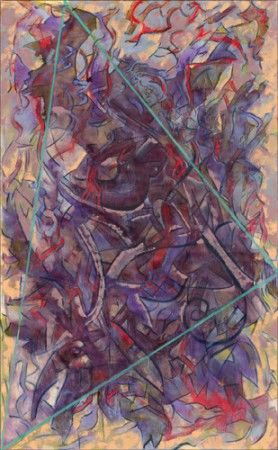Ricardo Morin
My work Triangulation Series 2006-08 expands on questions dealing with perspectives synthesizing concepts of pictorial space and infinity: something I have worked on over the years. I have allowed painterly abstraction/plasticity to express both in form and content a kind of art that goes beyond a material world of signs; my paintings reach for the infinite—the mystery and the poetry in every man’s individual drama. Though immersed in 20th-century aesthetics, I neither strive for a specific historical movement nor for the postmodernist agenda. Simply, I look at making art as a "fleshy" product of human experience, a resultant of the maker’s time. Just as idiosyncratic nature is blind to causality, an aesthetic frame embraces all its senses and the image is the result or residue.
Autobiographical, ritualistic, or even devotional—in this sense—the image or Kunstgegenstand seeks not to explain what the meaning of experience is; rather, the image manifests itself, provoking interpretation.
There are no outside sources nor preconceived notions of the final composition. Gesturally and intuitively, I use the plane of the canvas as an active platform (in other words, a conversation, so to speak, takes place among the paint, the canvas and me as I apply paint onto the canvas.) In variegated densities, layer after layer—transparent or textural—the work transforms itself gradually by spectral accruement. In continuous dialogue, I work on several pieces at the same time so all are able to inform the other. An inner rhythm from each composition thus unfolds and guides the shifts and the construction of forms: burials, resurrections, exaltations, veilings, reattainments—all thanks to the gritty and sumptuous nature of the medium; a moodiness arises from the interlocutors with its acrid qualities of dissonance and complementary transparency. Indeed, it is color, as texture that establishes the emotional landscape of each piece. The finished work stands on its own as a concentration of multiple layers; each of the numerous strata is essential to the completeness. There is a sense of multidirectional movement in each of the works that acts on the viewer’s eye as he/she glances over the delineated shapes and peers through the entanglements of strokes and arabesques. The viewer comes away, I hope, with the sense of the works’ generative completeness of a universe making and remaking itself.
As I said at the beginning, I search for a degree of universality through the unifying mode from the masters of the classical West. It is they who lead me as I wander around in my space of today’s uncertain and leaderless being, where authority is seemingly derived from conflicting, confusing powers of disbelief. Freedom has come to us but its ethers and incongruities make us stagger.


